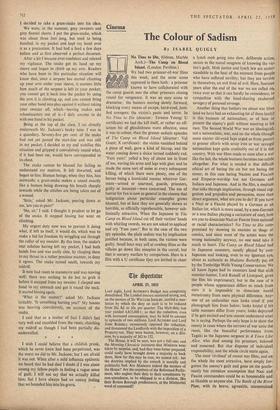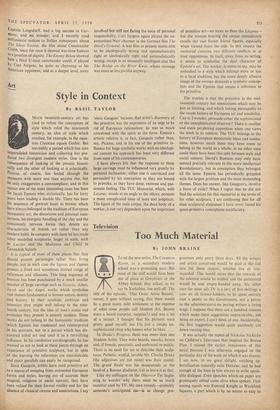Cinema
The Colour of Sadism
By ISABEL QUIGLY No. Time to Die, (Odeon, Marble Arch.)—The Camp on Blood Island. (London Pavilion.) WE had two prisoner-of-war films q this week, and the same scene ancilappeared in them both: a prisoner known to have collaborated with , ,, the camp guards sees the other prisoners closing round for vengeance. It was an easy scene to dramatise : the hunters moving slowly forward, blocking every means of escape, hard-eyed, justi- fied avengers; the victim's panic and terror. In No Time to Die (director : Terence Young; U certificate) we had the kill itself, or rather an off- screen bit of ghoulishness more effective, since it was in colour, than the grosser sadistic episodes of The Camp on Blood Island (director : Val Guest; X certificate): the victim vanished behind a piece of wall, gave a kind of hiccup, and the water coming down a sluice turned suddenly red. 'Yum yum !' yelled a boy of about ten in front of me, waving his arms and legs with glee; and he made the same sort of noise at every subsequent killing, of which there were plenty, one of the heroes being a homicidal maniac wherever Ger- mans—armed or unarmed, guards, prisoners, guilty or innocent—were concerned. The use of horror for fun is now so general in the cinema that indignation about particular examples grows blunted; but at least they are generally shown as horrible, as officially reprehensible, however sub- liminally attractive. When the Japanese in The Camp on Blood Island cut off their victims' heads with whirling swords, we are not asked to applaud and cry 'Yum yum!' But in the case of the two spy episodes, the plain sadism was by implication justified because, in both cases, the victims were guilty. Small boys may yell at cowboy films as the villains go down like ninepins in the corral; but that is nursery warfare by comparison. Here in a film with a U certificate they are invited to cheer a lynch mob going into slow, deliberate action, secure in the moral snugness of knowing the vie- tim's guilt. Mob justice and lynch law are under- standable in the heat of the moment from people who have suffered terribly; but they are terrible in themselves, an evil fruit of evil. Here, fourteen years after the end of the war we are called on, twice over so that it can hardly be coincidence, to sympathise with the head-shaving exuberant savagery of personal revenge.
Another thing that bothers me about war films (and we have had an exhausting lot of them lately) is this business of nationalism; or of how to present the enemy's guilt without sneering at his race. The Second World War was an ideological, not a nationalistic, war, and on the whole (though some sinister slit-eyed Japs urged us from posters to greater efforts with scrap iron or war savings) nationalism kept quite creditably out of it in this country. With war films made so soon after a war like the last, the whole business becomes too subtle altogether. For what is needed is that difficult ethical art of hating the sin but not hating the sinner, in this case hating Nazism and Fascism and Emperor-worship but not Germans and Italians and Japanese. And in the film, a medium that talks through implication, through visual sug- gestion and prejudice and persuasion, more than direct argument, what are you to do? If you have a Nazi or a Fascist played by a German or all Italian (or, which is more usual, by a non-German or a non-Italian playing a caricature of one), how are you to dissociate Nazi or Fascist from national or racial characteristics? No Time to Die com- promised by showing its enemies as thugs or comics, and since most of the actors were the wrong nationality anyway, no one need take it much to heart. The Camp on Blood Island had its Japanese monsters, mostly played by non- Japanese and looking, even to my ignorant eye, about as authentic as Madame Butterfly put on by the Tunbridge Wells Young Conservatives. We all know Japan had its monsters (and that aich monster-hunter, Lord Russell of Liverpool, gives the film his imprimatur); but in the case of a people whose appearance differs so much from ours it is impossible to dissociate moral monstrosity from mere physical difference. Any- one of an unfamiliar race looks cruel if you photograph him from below; looks brutal if his table manners differ from yours; looks depraved if he gets excited and you cannot understand what he is saying. Perhaps the only hope is to show the enemy in cases where the sorrows of war unite the races, like the beautiful performance from Tagaki as the Japanese sergeant in A Town Like Alice, who died among his prisoners, beloved and mourned. But that disposes of individual responsibility; and the whole circle starts again.
The most 'civilised' of recent war films, and on the whole the most attractive, have simply for- gotten the enemy's guilt and gone on the gentle- manly but mistaken assumption that Nazi and Fascist commanders could be as honourable and as likeable as anyone else. The Battle of the River Plate, with its brave, agreeable, uncommitted Captain Langsdorff, had a big success in Ger- many, and no wonder; and I recently read enthusiastic notices in Italian newspapers about The Silent Enemy, the film about Commander Crabb, since for once it showed war-time• Italians in a position of dignity. The Enemy Below showed how a Nazi U-boat commander could, if played by Curt Jurgens, be quite as charming as his American opponent; and at a deeper level, more involved but still not facing the issue of personal responsibility, Curt Jurgens again played the un- committed Nazi charmer in the German film The Devil's General. A war film at present seems able to be ideologically wrong and nationalistically right or ideologically right and nationalistically wrong; except in an unusually intelligent case like The Bridge on the River Kwai, whose message was more or less pacifist anyway.















































 Previous page
Previous page